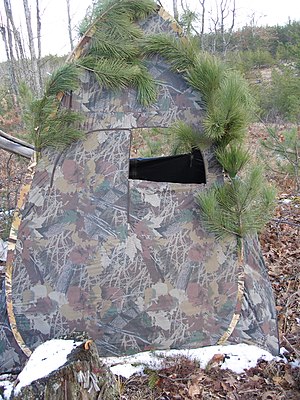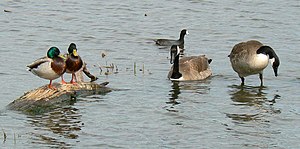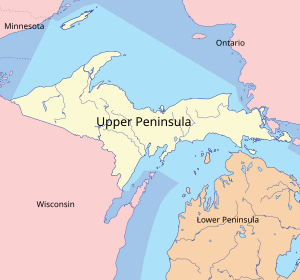 Image via Wikipedia
Image via WikipediaMADISON – August 1 is an important harvest permit application deadline for
hunters and trappers. Applications are due for the following seasons: fall wild turkey, Canada geese in the Horicon Zone, sharp-tailed grouse, bobcat, fisher and otter. Any fall turkey permits remaining after the initial drawing will go on sale beginning at noon on Saturday, August 27, and will be sold by zone until sold out or the season ends.
2011 Fall Season Dates:
- Fall Turkey: statewide Sept. 17 to Nov. 17; Nov. 28 to Dec. 31 in zones 1-5 ONLY
- Canada Geese, Horicon Zone: season dates are tentative and will not be set by the Natural Resources Board until August 10. Horicon Zone is proposed for Sept. 16 to Dec. 16 (first time period Sept. 16 through Oct. 30; second time period Oct. 31 through Dec. 16). Horicon Zone hunters are expected to receive six harvest tags for their time period.
- Canada Geese, Collins Zone: The Collins Zone has been eliminated and is now part of the Exterior Zone.
- Sharp-tailed Grouse: Oct. 15 through Nov. 6.
- Bobcat hunting and trapping (north of Hwy 64 only): Period 1: Oct. 15 through Dec. 25; Period 2: Dec. 26 through Jan. 31, 2012
- Fisher: trapping only: Oct. 15 through Dec. 31
- Otter: trapping only: North Zone: Nov. 5 through April 30, 2012; central & south zones: Nov. 5 through March 31, 2012
Permits can be applied for through the
Online Licensing Center on the Department of Natural Resources website, at all
license sales agents, and at
DNR Service Centers (Hours for service centers vary; check the DNR website for service center days and hours of operation; DNR Service Centers are not open on Saturdays), or by calling toll-free 1-877-LICENSE (1-877-945-4236). A bobcat permit application costs $6; all other permit applications cost $3.
“Our DNR Call Center staff can also help answer any questions folks may have about the permit application process,” said Dave Argall, DNR permit sales coordinator.” The DNR Call Center is staffed by live operators from 7 a.m. to 10 p.m., seven days a week, and can be reached at (888) WDNR-INFo (1-888-936-7463).
Fall Turkey
There will be 95,700 wild turkey permits available to hunters for the fall 2011 turkey hunting season, the same number that was available during the 2010 fall season. While the 16 percent decline in harvest during the spring 2011 season has elicited some concern among some hunters, turkey numbers rise and fall largely in response to weather conditions that influence winter survival and poult production. As well, the reduced harvest was partly the result of poor weather conditions during portions of the spring season, which reduced hunter effort and success, and altered turkey behavior. The limited hen harvest that has characterized recent fall turkey seasons does not have a large impact on turkey populations in the state. Turkey numbers will recover given mild winters and warm, dry conditions during the critical June brood-rearing period. Turkey hunters can therefore still expect excellent opportunities to pursue turkeys during the fall 2011 season.
The 2011 fall season will run from Sept. 17 through Nov. 17 for all seven of Wisconsin’s turkey management zones. Pending legislative approval of a proposed rule change, an extended fall turkey season for Zones 1-5 ONLY will run from Nov. 28 through Dec. 31,. If the extended season is approved, hunters who receive a fall turkey permit in Zones 1-5 would be able to fill their unused permits during the extended season in the zone for which they were issued. Hunters may use dogs to hunt wild turkeys during the fall season throughout the state of Wisconsin. The bag limit is one turkey of any age or sex per fall turkey hunting permit (also known as a carcass tag).
New turkey harvest registration procedures
Starting with the fall 2011 turkey season, hunters will be able to register their turkey by telephone or on-line. No in-person registration stations will be available. All harvested turkeys must be registered by telephone by calling the DNR’s Harvest Registration System at 1-888-HUNT-WIS (1-888-486-8947) or on-line via the DNR website. The phone-in system will accept either touch tone entry or voice commands (e.g., press or say 1). Hunters will be asked to record a harvest registration confirmation number on their hunting permit at the end of the call or on-line session. Hunters will still have until 5 p.m. on the day after harvest to register their turkey. The
wild turkey page of the DNR website will have updates regarding specific registration procedures.
Sharp-tailed Grouse
For 2011, 250
sharp-tailed grouse hunting permits will be available. This is a decrease from 2010 when 330 permits were available. The reduction in permits is the result of a combination of a variety of factors, including a decline in survey numbers throughout the sharp-tailed grouse range, continued habitat loss or conversion, increasingly isolated populations, and cyclical grouse population dynamics, according to wildlife biologists.
“A couple properties experienced either no change or a slight increase in observations of sharp-tailed grouse; however, survey numbers as a whole were down from 2010,” said Sharon Fandel, DNR assistant upland wildlife ecologist.
Sharp-tailed grouse management units use the same boundaries and designations as
deer management units (DMUs). In 2011, only one unit will have permits available. DMU 2 will have 250 permits. DMU 8, which was open in 2010, will be closed in 2011 due to low survey numbers observed at Namekagon Barrens Wildlife Area, one of the focal sharp-tailed grouse properties in the unit.
“Although there were a few more birds observed this spring in a couple areas, some of our traditional sharp-tailed grouse dancing grounds and managed properties continue to decline, warranting a cautious and conservative approach in our harvest framework,” said Fandel.
“Because sharp-tailed grouse occur at low densities across the landscape, it is often a challenge to locate
these birds,” she added. “Anticipating and allowing yourself to enjoy the experience of the hunt is encouraged and likely more realistic than the prospect of finding and harvesting a sharp-tail.”
Hunters are reminded to carefully review the zone map and apply only for units that are open. Applying for closed units will result in an invalid application.
FOR MORE INFORMATION CONTACT: Dave Argall, permit sales coordinator, at (608) 267-7699; Sharon Fandel, assistant upland wildlife ecologist – (608) 261-8458; James Christopoulos, assistant migratory bird ecologist – (608) 695-1220; or Shawn Rossler, assistant furbearer ecologist – (608) 220-8456
 Image via WikipediaOperation Deer Watch 2011
Image via WikipediaOperation Deer Watch 2011 
































